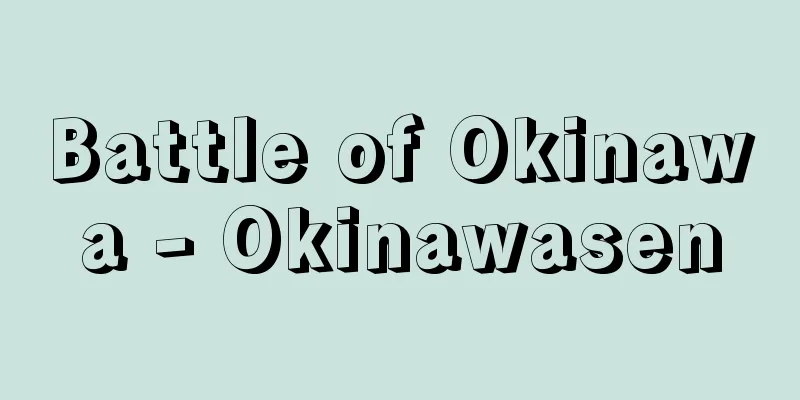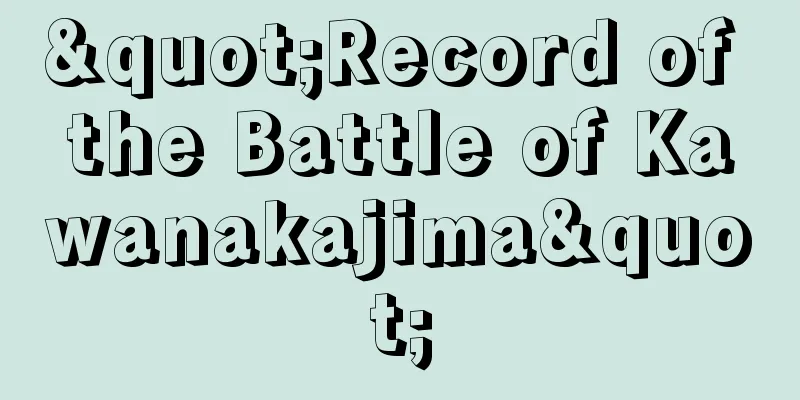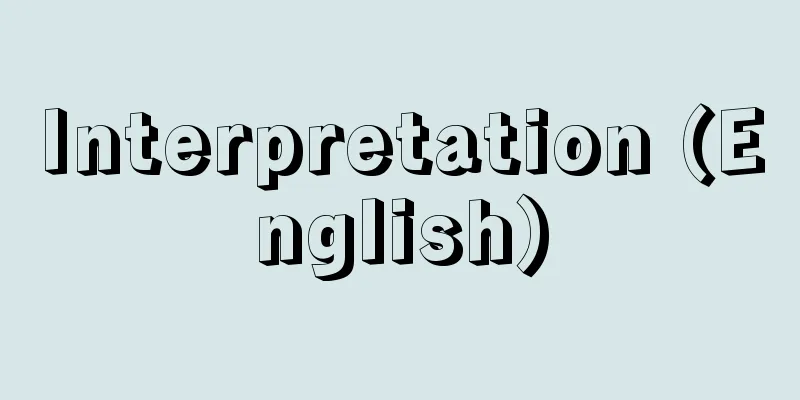Battle of Okinawa - Okinawasen

|
A ground battle between the Japanese and American armies that took place on the Okinawa Islands in the final stage of the Pacific War. It is sometimes called "the final battle between the Japanese and American armies" or "the Battle of Okinawa." [Takara Kurayoshi] The Night Before the BattleIn March 1944, with the war situation reaching its climax, the 32nd Army (Commander Ushijima Mitsuru) was formed to defend the Nansei Islands as a defense line for the mainland battle. After the military was relocated to Okinawa, they conscripted men and women from the prefecture to carry out rush construction work, aiming to set up an air base and turn the entire island into a fortress. However, on October 10, 1944, with the Battle of Leyte looming, the US military carried out a massive air raid on the entire Nansei Islands (the 10.10 air raid), which caused serious damage to the facilities and fighting power of the defending army, and the lives of the prefecture's residents were also greatly affected, with Naha City being almost completely burned down. Moreover, the main force of the 32nd Army was soon selected for the Philippines operation, and the military leaders were forced to supplement their troops from the prefecture's residents through local conscription and defense mobilization, and to change their operations to a strategic endurance operation. At the start of the Battle of Okinawa, the garrison force was said to be about 100,000 strong, but about one-third of them were merely replacement forces, and weapons and ammunition were weak. In contrast, the US military had a land invasion force of 173,000, and logistical support forces totaling 440,000, giving them an overwhelming advantage in terms of weapons and ammunition. With the situation inevitably turning into a battlefield, about 100,000 people evacuated outside the prefecture (Kyushu, Taiwan), but due to the dangers at sea and a lack of ships, they were unable to achieve their intended goal, and most of the prefecture's residents remained within the prefecture, which would soon become a battlefield. Many of the evacuees experienced tragedies such as the sinking of the Tsushima Maru (August 22, 1944), when a ship carrying about 800 children was sunk by a US submarine. [Takara Kurayoshi] Battle ProgressAfter the fall of Iwo Jima, the US military immediately launched the Okinawa invasion operation (Operation Iceberg), and began heavy air and naval bombardment of the Okinawa Islands from March 23, 1945. On the 26th, the US military landed on the Kerama Islands and secured the island, and on April 1, they finally launched an invasion of the west coast of central Okinawa Island. Because the Japanese military had stationed their main forces around the Urasoe Escarpment, centered around Shuri, the US military was able to complete the invasion without any real resistance, dividing Okinawa Island into north and south, and developing operations to take control of the northern part and the various outlying islands, while their main forces advanced south and launched an all-out attack on the main force of the Japanese army around the 7th. The fierce battle between the two armies on the Urasoe Escarpment, north of Shuri, lasted for over 40 days, with both sides suffering heavy losses. In particular, the Japanese army lost the main force in this battle, and so on May 22nd they abandoned their base in Shuri and retreated to the south (Shimajiri) with their remaining forces of about 40,000 (some say 30,000) to continue the resistance, including guerilla warfare. Ordinary citizens of the prefecture (estimated to be over 100,000) who had been driven by the fighting also took refuge in the narrow south, resulting in a state of panic among military and civilians alike, which was then followed by a fierce attack by the US military, creating a harsh situation. The Japanese army drove residents out of their caves, massacred them, and stole food, and the residents became terrified of the atrocities not only of the US military but also of the Japanese army. The Japanese military's defense line around Mt. Yaese in the south, which had been barely set up, was breached by the US military around June 18th, so Commander Ushijima issued his final order to "fight bravely to the end and live for the eternal cause," and committed suicide in the military headquarters trenches at Mabuni in the early hours of the 23rd. This marked the final end of organized resistance by the Japanese military, but the US military continued their mopping-up operations, and by the end of June, about 9,000 Japanese soldiers had been killed, and around 80,000 ordinary women and children had been interned. Many of the student corps, including the Himeyuri Unit, and the defense forces called up on the ground also met a tragic end in caves or on the beaches at the southern end. It was on July 2nd that the US military announced the end of their Okinawa invasion operations. [Takara Kurayoshi] Damage and characteristicsIn the three-month battle, 65,908 Japanese soldiers (excluding those from Okinawa), 12,281 US soldiers, and 28,228 military personnel and civilian employees from Okinawa were killed. In addition, an estimated 94,000 civilians were killed (according to the Prefectural Assistance Division). There were various cases of civilians killed in battle, such as mass suicides, massacres by the Japanese military, deaths from malaria caused by forced relocations ordered by the military, and entire families wiped out, and the actual number remains unknown to this day. The fact that there were more civilians killed in battle than combatants clearly shows the characteristics of the Battle of Okinawa. This is because the US military, which was trying to take control of Okinawa in one go by investing large amounts of material in order to smoothly advance on the mainland, and the Japanese military, which was fighting with all its might under the premise of a bleeding operation in order to prolong the advance on the mainland for even one more day, fought in a way that involved the civilians as well. It is said that there are still many remains of war dead that have not been collected in various parts of Okinawa. Not only were human lives lost, but many cultural heritage sites, including 21 national treasures, were reduced to ashes. It is said that all current Okinawans are victims or bereaved in some way, including those who lost family members or were injured in the war. Researchers consider the Battle of Okinawa to be the "conclusion" of modern Okinawa, and at the same time, the "origin" and "starting point" of postwar Okinawa. June 23rd every year is a public holiday in Okinawa Prefecture, designated as "Memorial Day," on which various gatherings are held, including a joint memorial service organized by the prefecture. On the 50th Memorial Day in 1995, an unveiling ceremony was held for the "Cornerstone of Peace," which was constructed in the Peace Memorial Park in Itoman City. The "Cornerstone of Peace" is a monument on which the names of all those who died in the Battle of Okinawa are inscribed. The Mabuni area in the south, which was a fierce battlefield, has been designated the Okinawa Battlefield Quasi-National Park, where various memorial towers have been erected, and caves that tell the story of the time of the Battle of Okinawa still exist in various places. [Takara Kurayoshi] Defense Agency War History Office (ed., Army Operations in the Okinawa Area, Naval Operations in the Okinawa Area (both 1968, Asagumo Shimbunsha)) ▽ U.S. Department of the Army (ed., The Final Battle between the United States and Japan, translated by Tono Seishiro, 1968, Simul Publishing) ▽ Ryukyu Government (ed., Okinawa Prefecture History 9, 1971) ▽ Okinawa Prefecture History 10, 1974, Okinawa Prefectural Board of Education) ▽ Ikemiyagi Hideyoshi (ed., Japan's Air Raids 9: Okinawa, 1981, Sanseido) ▽ Ota Masahide (ed., Complete History of the Battle of Okinawa, 1982, Iwanami Shoten) ▽ Monthly Okinawa Publishing (ed., Okinawa Battle Record Photo Collection: Japan's Last Battle, 1993) ▽ Aniya Masaaki (ed., For the Study of the Battle of Okinawa, 1997, Heiwa Bunka) ▽ Okinawa Times (ed., Photo Record Postwar History of Okinawa, revised and expanded edition (1998) ▽ Miyazato Masaharu and Gabe Masao, Photographs and Records of the Battle of Okinawa, Complete Documents with Document Catalog, CD-ROM edition (1999, Japan Library Center) ▽ Fujiwara Akira (ed.), The Battle of Okinawa - When the Land Became a Battlefield, New Edition (2001, Aoki Shoten) ▽ Ishihara Masaie, Oshiro Masayasu, Hosaka Hiroshi and Matsunaga Katsutoshi, Points of Issue: Memories of the Battle of Okinawa (2002, Shakai Hyoronsha) ▽ Ota Masahide, The Heart of Okinawa - The Battle of Okinawa and Me (Iwanami Shinsho) [Reference items] | | | | | |©Shogakukan "> Japanese military forces in the central and southern parts of Okinawa Island during the Battle of Okinawa… Source: Shogakukan Encyclopedia Nipponica About Encyclopedia Nipponica Information | Legend |
|
太平洋戦争の最終段階で沖縄諸島を舞台に戦われた日米両軍による地上戦。「日米最後の戦闘」「沖縄決戦」と称されるときもある。 [高良倉吉] 戦闘前夜戦局も押し詰まった1944年(昭和19)3月、本土決戦の防備ラインとして南西諸島を守備すべく第三二軍(牛島満(みつる)司令官)が編成された。沖縄移駐後、軍は航空基地の設定と全島要塞(ようさい)化を目ざして県民男女を徴用し突貫工事を敢行する。しかし、1944年10月10日、レイテ決戦を目前にした米軍の南西諸島全域に対する大空襲(10.10空襲)により守備軍の施設、戦力は甚大な被害を受け、また、那覇市がほぼ全焼するなど県民生活も大きな打撃を被った。しかも第三二軍の主力部隊がやがてフィリピン作戦に抽出されたため、軍首脳は現地徴兵、防衛召集などを通じて県民のなかから即席の兵力を補充するとともに、作戦も戦略持久作戦に変更せざるをえなくなった。沖縄戦開戦時の守備軍は約10万といわれるが、その約3分の1は先の補充兵力にすぎず、兵器、弾薬とも劣弱であった。これに対して米軍は、陸上攻略部隊17万3000、後方支援部隊をあわせると実に44万にも及び、兵器、弾薬の面でも圧倒的に優勢であった。戦場化必至の情勢下で県外(九州、台湾)へ約10万人が疎開したが、海上の危険と船腹の不足で所期の目標を達成できず、大半の県民はやがて戦場となる県内にとどまった。疎開者のなかには、約800名の児童を乗せた船が米潜水艦によって撃沈された対馬(つしま)丸遭難事件(1944年8月22日)のような悲劇に遭遇した人も多い。 [高良倉吉] 戦闘経過硫黄(いおう)島陥落後、米軍はただちに沖縄攻略作戦(アイスバーグ作戦)に着手し、1945年3月23日から沖縄諸島に激しい空襲、艦砲射撃を加えた。26日慶良間(けらま)列島に上陸して同島を確保した米軍は、4月1日、いよいよ沖縄本島中部西海岸に上陸作戦を開始した。日本軍は主力を首里(しゅり)を中心とする浦添(うらそえ)高地一帯に配置していたため、米軍は抵抗らしい抵抗も受けずに上陸を完了して沖縄本島を南北に分断、北部および各離島制圧のための作戦を展開する一方、主力は南進して7日ごろから日本軍主力に総攻撃を開始した。首里の北方浦添高地で展開された両軍の死闘は40日余に及び、両軍とも大きな損害を被った。とくに日本軍は主力部隊をこの戦闘で失ったため、5月22日、拠点であった首里を放棄し残存兵力約4万(一説では3万)をもって南部(島尻(しまじり))に撤退し、ゲリラ戦的抵抗を含む抗戦を続行することとした。狭い南部には戦火に追われた一般県民(推定10万人以上)も避難したため、軍民混在のパニック状態に陥り、そこに米軍の激しい攻撃が加えられたため過酷な状況が展開した。日本軍による壕(ごう)追い出し、住民虐殺、食糧強奪が発生し、住民は、米軍はおろか日本軍の暴虐行為にまで恐れおののく事態となった。南部にかろうじて設定された八重瀬岳(やえせだけ)一帯の日本軍防衛線も6月18日ごろには米軍に突破されたため、牛島司令官は「最後まで敢闘し悠久の大義に生くべし」と最後の命令を発し、23日未明、摩文仁(まぶに)の軍司令部壕において自決した。ここに日本軍による組織的抵抗は最終的に終了したが、米軍は引き続き掃討戦を展開、6月末までに約9000人の日本兵が犠牲となり、8万人ほどの一般婦女子が収容されたという。「ひめゆり部隊」をはじめとする学徒隊や、現地応召の防衛隊の多くも南端の洞窟(どうくつ)や海岸で悲惨な最期を遂げた。米軍が沖縄攻略作戦の終了を宣言したのは7月2日のことである。 [高良倉吉] 被災と特徴3か月余の戦闘で日本軍将兵(県出身者を除く)6万5908人、米軍将兵1万2281人、県出身軍人・軍属2万8228人の戦死者が出た。また、一般県民9万4000人(推定)が犠牲となった(以上県援護課資料による)。県民のなかには集団自決や日本軍による虐殺の例、軍命により強制移住させられマラリアにかかり死亡した例、あるいは一家全滅した例などさまざまな戦死例があり、実数は今日に至るまで判明していない。戦闘員よりも一般住民の戦死者が多いという事実に沖縄戦の特徴がよく表れている。それは、本土進攻をスムーズに運ぶため物量を投入して一気に沖縄を制圧しようとする米軍と、本土進攻を1日でも長引かせるため出血作戦を前提に総力戦を展開する日本軍とが、県民をも巻き込む形で戦闘を行ったからである。沖縄の各地にはいまなお未収集の戦死者の遺骨が数多く存在するといわれている。また、人命ばかりでなく、21件も存在した国宝文化財をはじめとする多くの文化遺産がことごとく灰燼(かいじん)に帰した。戦争で肉親を失った者、傷ついた者など現在の沖縄県民のすべてがなんらかの形で被害者、遺族だといわれている。研究者の間では、沖縄戦は近代沖縄の「結論」であると同時に、戦後沖縄の「原点」「起点」と規定されている。 毎年6月23日は「慰霊の日」として沖縄県では公休日であり、県主催の合同追悼式をはじめ各種の集会が開催されている。50回目にあたる1995年(平成7)の「慰霊の日」には、糸満(いとまん)市の平和祈念公園内に建設された「平和の礎(いしじ)」の除幕式が行われた。「平和の礎」は沖縄戦で戦死した全犠牲者の氏名が刻まれた記念碑。激戦地となった南部の摩文仁一帯は沖縄戦跡国定公園に指定され、各種の慰霊塔が建立されており、また、沖縄戦当時そのままのようすを伝える洞窟などがいまなお各所に存在している。 [高良倉吉] 『防衛庁戦史室編『沖縄方面陸軍作戦』『沖縄方面海軍作戦』(ともに1968・朝雲新聞社)』▽『米国陸軍省編、外間征四郎訳『日米最後の戦闘』(1968・サイマル出版会)』▽『琉球政府編・刊『沖縄県史 9』(1971)』▽『『沖縄県史 10』(1974・沖縄県教育委員会)』▽『池宮城秀意編『日本の空襲 9 沖縄』(1981・三省堂)』▽『大田昌秀編著『総史沖縄戦』(1982・岩波書店)』▽『月刊沖縄社編・刊『沖縄戦記録写真集 日本最後の戦い』(1993)』▽『安仁屋政昭編著『沖縄戦学習のために』(1997・平和文化)』▽『沖縄タイムス社編・刊『写真記録 沖縄戦後史』改訂増補版(1998)』▽『宮里政玄・我部政男著『写真・記録沖縄戦全資料 資料目録付き』CD-ROM版(1999・日本図書センター)』▽『藤原彰編著『沖縄戦――国土が戦場になったとき』新装版(2001・青木書店)』▽『石原昌家・大城将保・保坂広志・松永勝利著『争点・沖縄戦の記憶』(2002・社会評論社)』▽『大田昌秀著『沖縄のこころ――沖縄戦と私』(岩波新書)』 [参照項目] | | | | | |©Shogakukan"> 沖縄戦における沖縄本島中南部の日本軍配… 出典 小学館 日本大百科全書(ニッポニカ)日本大百科全書(ニッポニカ)について 情報 | 凡例 |
<<: Okinawa pufferfish - Okinawa pufferfish
Recommend
Liberal League
...They recognized the unification of the British...
Nichinan [town] - Nichinan
A town in Hino County in southwestern Tottori Pref...
Didacus
…Born into a noble family in Castile, Spain, he s...
Kruszewski, M.
… [Pioneers of structural linguistics] From the e...
Substructure - Kabukozo (English spelling) Unterbau German
In historical materialism (Marxist social science...
Aogarebushi - Aogarebushi
…Then, after drying in the sun, the mold on the s...
Righteous Army Struggle (English: Righteous Army Struggle)
A popular resistance movement against invaders in ...
rotonde
…Many of them have dome-shaped ceilings or roofs....
Law of diminishing returns
A fundamental proposition in economics regarding ...
Kamehameha [the Great] - Kamehameha
Founder of the Kingdom of Hawaii. In 1782, he asce...
chum
… [Siberian hunter's tent chum] The forest st...
Inserted head - Kazashi
〘Noun〙 (Noun derived from the conjunctive form of ...
Heredity - Iden (English spelling) heredity
Originally, it meant the phenomenon in which cert...
Ethylenediaminetetraacetic acid (English spelling)
Also known as ethylenediaminetetraacetic acid, ab...
afferent branchial vein
…an organ found only in mollusks such as cephalop...







![Arab [species] - Arab](/upload/images/67cadbcf6a61a.webp)

